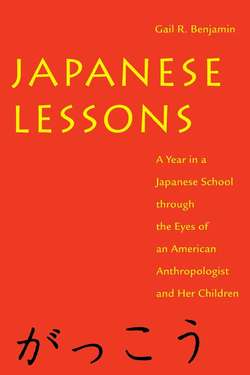Читать книгу Japanese Lessons - Gail R. Benjamin - Страница 14
На сайте Литреса книга снята с продажи.
A FULL-TIME OCCUPATION
ОглавлениеLike other occupations in Japan, being an elementary schoolchild is considered a full-time job. This seems a reasonable assessment of the role school plays in the lives of children. Consider the days and hours that elementary school occupies. Elementary school is in session 240 days a year, for forty-one hours each week (less for first graders). The forty-one hours include Monday through Friday from 8:30 A.M. to 3:40 P.M., 8:30 to 12:30 on Saturday, and one hour of required club meeting on Wednesday afternoon. Japanese children go to school 1,640 hours a year. American elementary schools vary but are typically in session 180 days a year, thirty-two and a half hours a week, or 1,070 hours a year.
By comparison, U.S. Civil Service employees are considered to have a working year of 2,080 hours per year, only 440 hours more than Japanese children put in. American children are “at work” about half time compared with these American adults. Adults, of course, don’t have homework at night and during vacations, as Japanese and American children do. If we compare schooltime for Japanese and American children in terms of school days, then the Japanese children spend the equivalent of twelve more weeks a year in school than American children. They spend the equivalent of seventeen more weeks in school in terms of hours at school.
But as we have seen from Sam’s and Ellen’s schedules, not all school time in Japan is class time. For Sam about eleven hours a week was taken up with recess, lunch, cleaning, and other nonclass activities. These are all considered educational in the wider sense in Japan, but they are not class hours. In the United States we might reasonably estimate that one hour a day, or five hours a week, is spent in recesses and lunch periods. In terms of class hours, then, Japanese students have about 1,200 hours a year, Americans 890 hours. This translates to a difference of almost ten weeks more class time for the Japanese students.
School, then, simply takes up more time for Japanese children than for American children. The importance of school, defining the Japanese child’s status and occupation, is reflected in other ways too. One is that children are seldom identified by age but rather by grade in school. Parents say, “My son is a third grader” instead of “My son is nine years old.” Adults scold children by saying, “That’s not how a sixth grader should behave.” Strangers ask a child, “What grade are you in?” not “How old are you?”
A second sign of the importance of school and the occupation of being a schoolchild is all the equipment and specialized paraphernalia required for elementary school children, different from that used by older students or adults. Besides the materials mentioned in the first chapter, a desk and study space are provided for each student in even the most cramped and crowded house. Each winter as the preparations for a new school year in April get under way and stores begin major promotions of school materials, there are special sales on these desks. They cost about Y50,000 ($355) for the desk, plus Y15,000 ($100) for the chair. The desks all have a place to hang the backpack, a light, a timer for practice tests, a place to put the weekly schedule, and a buzzer. Everyone knows that the buzzer will be used to call Mother to bring a snack or to help with homework or just to offer encouragement and sympathy.
